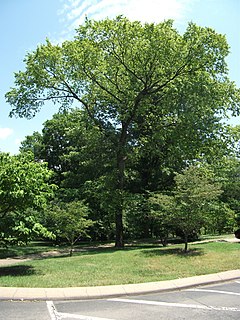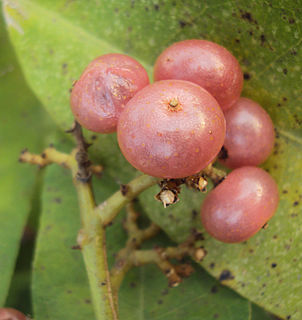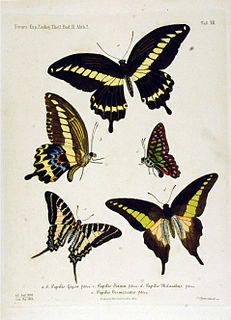
Ulmus crassifoliaNutt., the Texas cedar elm or simply cedar elm, is a deciduous tree native to south central North America, mainly in southern and eastern Texas, southern Oklahoma, Arkansas and Louisiana, with small populations in western Mississippi, southwest Tennessee and north central Florida; it also occurs in northeastern Mexico. It is the most common elm tree in Texas. The tree typically grows well in flat valley bottom areas referred to as 'Cedar Elm Flats'. The common name 'cedar elm' is derived from the trees' association with juniper trees, locally known as cedars.

Ulmus serotinaSarg., the September elm, is an autumn-flowering North American species of tree. It is uncommon beyond Tennessee; only very locally distributed through Illinois, Kentucky, Arkansas, Mississippi, Oklahoma, Alabama and Georgia, and disjunct into Nuevo León, Mexico. It grows predominantly on limestone bluffs and along streams to elevations of 400 m.
This timeline of extinctions is an historical account of species that have become extinct during the time that modern humans have occupied the Earth.
Picea crassifolia, the Qinghai spruce, is a species of conifer in the family Pinaceae. It is found only in China.
Beauprea crassifolia is a species of plant in the family Proteaceae. It is endemic to New Caledonia.

Glycosmis is a genus of flowering plants in the citrus family, Rutaceae and tribe Clauseneae. It is in the subfamily Aurantioideae, which also includes genus Citrus. It is a genus of the subtribe Clauseninae, which are known technically as the remote citroid fruit trees.
Glycosmis decipiens is a species of plant in the family Rutaceae. It is endemic to Peninsular Malaysia. It is threatened by habitat loss. A population is protected in Taman Negara.
Glycosmis monticola is a species of plant in the family Rutaceae. It is endemic to Peninsular Malaysia. It is threatened by habitat loss.
Glycosmis perakensis is a species of plant in the family Rutaceae. It is a tree endemic to Peninsular Malaysia. It is threatened by habitat loss.
Glycosmis tomentella is a species of plant in the family Rutaceae. It is endemic to Peninsular Malaysia. It is threatened by habitat loss.
Horsfieldia crassifolia is a species of plant in the family Myristicaceae. It is a tree that grows naturally in Sumatra, Peninsular Malaysia, Singapore and Borneo.
Macrozamia crassifolia is a species of plant in the family Zamiaceae. It is endemic to Australia.
Nostolachma crassifolia is a species of plant in the family Rubiaceae. It is native to Kerala and Tamil Nadu in India.

Oxera is a genus of flowering plants in the family Lamiaceae native to Vanuatu and New Caledonia in the western Pacific.

Oxera crassifolia is a species of plant in the family Lamiaceae. It is endemic to New Caledonia.
Rudgea crassifolia is a species of plant in the family Rubiaceae. It is endemic to Brazil. Its natural habitat is subtropical or tropical dry shrubland. It is threatened by habitat loss.
As of July 2016, the International Union for Conservation of Nature (IUCN) lists 238 conservation dependent species. 0.29% of all evaluated species are listed as conservation dependent. The IUCN also lists seven subspecies and five varieties as conservation dependent.

Papilio gigon is a butterfly of the family Papilionidae. It is confined to islands in eastern Indonesia, but common where found [1].

Glycosmis parviflora is a species of flowering plant in the family Rutaceae, known commonly as Chinese glycosmis and Jamaican Mandarin-orange. It occurs in China, Japan, Taiwan, Myanmar and Vietnam. It is widely naturalized in the tropics including in the West Indies. In temperate zones, it can be cultivated indoors as a houseplant.






